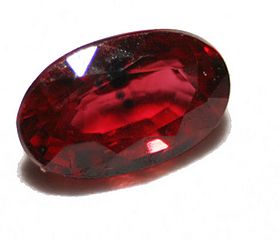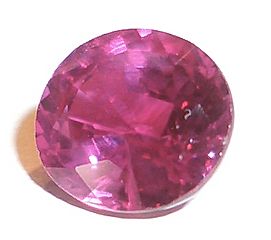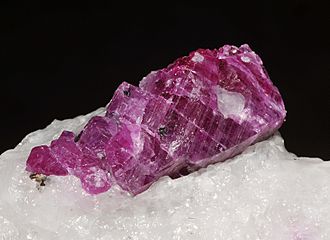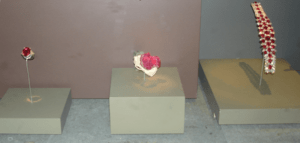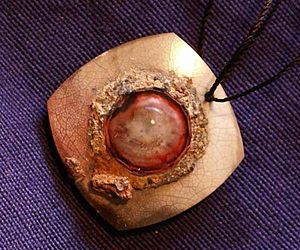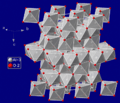Ruby facts for kids
Quick facts for kids Ruby |
|
|---|---|
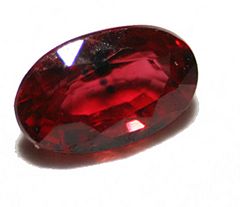
A ruby gemstone
|
|
| General | |
| Category | Mineral |
| Formula (repeating unit) |
aluminium oxide with chromium, Al2O3 |
| Identification | |
| Color | Red shades |
| Luster | Vitreous |
A ruby is a beautiful and valuable gemstone, famous for its bright red color. It's often grouped with other precious stones like emerald and sapphire. Rubies are made from aluminum and oxygen, with the chemical formula Al2O3.
Contents
What Makes a Ruby Valuable?
Just like other gemstones, rubies are judged by four main things. These are called the "four Cs": color, cut, clarity, and carat weight. Where a ruby comes from also affects its value.
The Importance of Color
For colored gemstones, color is the most important thing. A ruby's color has three parts: hue, saturation, and tone.
- Hue is the actual color, like red. Rubies are defined as red, but they can have hints of other colors like orange, purple, or pink.
- Saturation means how strong or vivid the color is. A highly saturated ruby has a very intense red.
- Tone refers to how light or dark the color is.
How Rubies Are Treated
It's common to treat gemstones to make them look better. Some treatments are used very often and are seen as normal. In the late 1990s, many treated rubies became available, which made ruby prices go down.
Treatments can change a ruby's color or make it clearer. They can also fix or fill in cracks.
Heat Treatment
The most common way to treat rubies is with heat. Many rubies are heated to improve their color. This can remove purple tints or blue spots. Heating also gets rid of "silk," which are tiny needle-like inclusions inside the stone. These heat treatments usually happen at very high temperatures.
Glass Filling
Another treatment that has become more common is filling rubies with lead glass. This process fills cracks inside the ruby with glass. It makes the stone much clearer and more suitable for jewelry.
This treatment involves a few steps:
- First, the rough stones are cleaned.
- Then, they are heated to remove impurities from the cracks.
- Finally, the ruby is heated again with special glass powder. This powder melts and fills the cracks. After it cools, the glass becomes clear, making the ruby look much better.
You can often tell if a ruby has been treated this way by looking for tiny bubbles inside the stone with a magnifying glass.
Famous Rubies and Records
- The National Museum of Natural History in Washington, D.C., has some of the world's largest and best ruby gemstones. One famous ruby there is the 23.1-carat Burmese ruby. It was given by Peter Buck in memory of his wife. This ruby has a rich red color and is very clear. It was found in the Mogok region of Myanmar in the 1930s.
- In 2007, a London jeweler showed a heart-shaped 40.63-carat ruby.
- In 2011, Elizabeth Taylor's jewelry collection was sold. A ruby ring with an 8.24-carat gem broke a record, selling for over US$4.2 million.
- The Liberty Bell Ruby is the largest mined ruby in the world. Sadly, it was stolen in 2011.
- The Sunrise Ruby is the most expensive ruby ever sold. It's also the most expensive colored gemstone (not a diamond). In 2015, it sold for US$30 million at an auction in Switzerland.
- A synthetic (man-made) ruby crystal was used to create the world's first working laser. This happened on May 16, 1961, thanks to Theodore Maiman. This ruby laser was the first device to work with light waves.
Rubies in History and Culture
- The Old Testament of the Bible mentions rubies many times. However, it's not always clear if the word used truly meant 'ruby' or other jewels.
- One of the earliest records of rubies being traded comes from the North Silk Road in China. Around 200 BC, rubies were carried along this ancient trade route, moving west from China.
- Rubies have always been highly valued in Asian countries. They were used to decorate armor, sword holders, and horse gear for noblemen in India and China. People even placed rubies under the foundations of buildings to bring good luck.
- In traditional Hindu beliefs, rubies are seen as the "gemstone of the Sun" and the god Surya. It is believed that wearing rubies can make the Sun favorable to the person.
- In Marvel comic books, the Godstone is a ruby found on the moon. It activates by moonlight and turns John Jameson into the Man-Wolf.
Images for kids
-
Rubies at the National Museum of Natural History, Washington, D.C., USA
See also
 In Spanish: Rubí para niños
In Spanish: Rubí para niños



